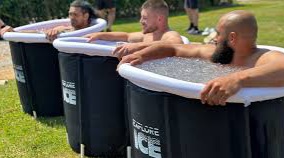Ice baths the cold, cruel love story of modern athletes. For decades, elite sports professionals have submerged themselves in freezing water post-training, gritting their teeth in the name of recovery. But beyond the initial shock and chill lies a fascinating science that quietly influences performance on and off the field.
So, what exactly do ice baths do, and why do top athletes keep coming back to them?
1. The Recovery Reset: Cooling Inflammation Fast
When athletes push their bodies to the limit, muscles suffer microscopic damage a necessary part of getting stronger. But with that damage comes inflammation, soreness, and fatigue. Ice baths (or cold water immersion therapy) help reduce this inflammation by constricting blood vessels and slowing down cellular activity.
Think of it like hitting pause on the internal swelling and pain. This faster cooldown allows athletes to train harder and more frequently without being sidelined by soreness.
Quick Stat: Studies show that cold water immersion can reduce muscle soreness up to 20–30% within the first 24–48 hours after intense exercise.
2. Psychological Edge: Training the Mind Through Discomfort
There’s a hidden mental layer to ice baths. Sitting still in freezing water often for 10 minutes or more is a battle against discomfort. Over time, this builds mental toughness, focus, and discipline, traits that translate directly into competitive performance.
Athletes like Novak Djokovic and LeBron James have praised the psychological benefits of cold exposure. It’s not just physical it’s about learning to stay calm and composed in uncomfortable conditions.
3. Improved Sleep = Better Performance
Cold therapy has been linked to better sleep quality. Lowering the body’s core temperature signals the brain it’s time to rest, promoting deeper, more restorative sleep a crucial ingredient for muscle repair and mental sharpness.
For athletes, that edge in recovery carries over to every training session and game day. A rested body performs better, reacts faster, and endures longer.
4. Circulation and Contrast Therapy: Boosting the Bounce-Back
Some athletes take it further by alternating between cold and warm water known as contrast water therapy. This hot-cold switching boosts circulation, flushing out metabolic waste and bringing fresh, oxygen-rich blood to tired muscles.
Over time, this can lead to faster healing, fewer injuries, and more efficient recovery cycles key for sports with packed schedules or back-to-back competitions.
5. The Real Talk: Not a Miracle Fix
Despite the benefits, ice baths aren’t magic. Recent research suggests they might blunt some muscle growth signals if overused, especially right after strength training. That’s why smart athletes and coaches time their ice baths strategically using them when recovery is the top priority, not when gains are.
Pro Tip: Ice baths are most effective after endurance workouts, heavy matches, or tournament days not necessarily right after strength or hypertrophy training.
A Chilling Secret Weapon
The real impact of ice baths lies in their subtle but consistent benefits. They don’t guarantee instant wins or overnight recovery but when used wisely, they become a powerful tool in an athlete’s performance arsenal.
In a world where every second, every sprint, and every recovery window matters, the cold truth is this: ice baths work, not just on the body, but on the mind. And that’s why the world’s best keep plunging back in.

